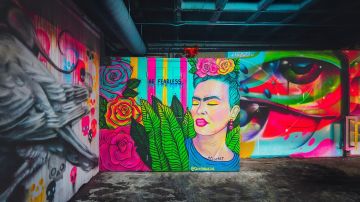Frida Kahlo and Diego Rivera Come Alive in New Exhibit
The profound bond between Frida Kahlo and Diego Rivera, which began years before they were married, continues long after their deaths

Photo: Unsplash/@joshstyle
The profound bond between Frida Kahlo and Diego Rivera, which began years before they were married, continues long after their deaths. Yet these two enrapturing modernists never exhibited together when they were alive. The Frida Kahlo, Diego Rivera, and Mexican Modernism from the Jacques and Natasha Gelman Collection is on display now through January 19, at the North Carolina Museum of Art, and it puts their work on the forefront as leaders of an art movement they made legendary.
In the mid-1930s, Frida Kahlo lived, worked, and thrived in the charming San Angel neighborhood in Mexico City, alongside her husband in separate but connected studios. I’ve often wondered what it was like to be in Mexico City during this revolutionary political era that was also exploding artistically. This exhibit is a time capsule. Visitors will get to see these artistic icons through the lens of two people who knew them well, and in a time when they were becoming famous. It’s a personal view from the collection that Jacques and Natasha Gelman amassed as expats living in Mexico City.

The couple (he a Russian and she a Czech) met in Mexico and shared a fascination with its culture and art scene, particularly Kahlo and Rivera. The two couples became close friends and both artists have their own rendition of Natasha. The show features both commissions of Natasha — Kahlo painted her portrait in her signature form, and Rivera painted her in Art Deco style so that she looked like a Hollywood starlet. Interestingly, Jacques was also a film producer and is credited with discovering actor Mario Moreno, better known as Cantinflas, and turning him into a full-fledged star. The exhibit also features a stunning Cubinism painting of Cantinflas by another Mexican Modernist, Rufino Tamay.

As someone who has ventured from Anaheim to London in search of Kahlo’s work in all its glory, I was not disappointed with his exhibit. From black-and-white images of the pair at the New Workers School to video footage of the two atop scaffolding on Rivera’s Detroit series, the exhibit brings to life a group show as if it were here in North Carolina. Fittingly, as Day of the Dead draws near, there’s a massive altar devoted to Kahlo at the entrance of the exhibit. The shrine is adorned lovingly with marigolds, and skulls of every size. There are also blank cards where visitors can leave their thought offerings to the late Mexican icon.

Other highlights of the exhibit include several of Kahlo’s famous dresses of which we have seen pictured in countless contexts. There’s also a digital interactive room that comes alive with Kahlo’s poignant writings and drawings — and several rare images of a frail Kahlo and a few photographs of her on her death bed as Rivera looks on sorrowfully.
But make no mistake, even though we know full well that Kahlo endured a life of physical pain and heartbreak, this is not a melancholic show. This display is a celebration of a movement that has transcended time and place. It’s a show that honors its King and Queen while also applauding Mexican Modernists that were also part of the movement with them — and those they have inspired.
View “Frida Kahlo, Diego Rivera, and Mexican Modernism from the Jacques and Natasha Gelman Collection” through January 19 at the North Carolina Museum of Art, 2110 Blue Ridge Rd, Raleigh, North Carolina, ncartmuseum.org, (919) 839-6262.

















